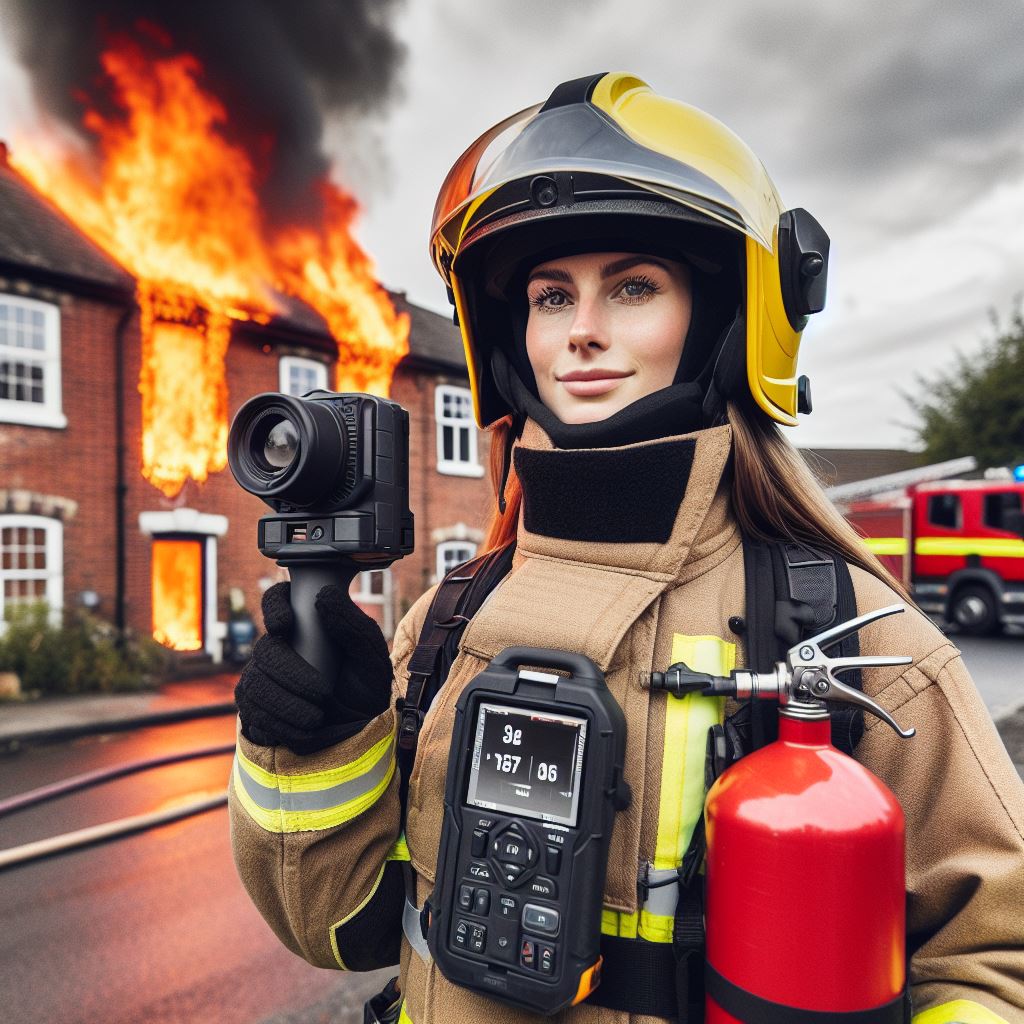Introduction
In the tapestry of UK history, fires weave tales of destruction and resilience. This blog post unearths notable blazes, extracting lessons learned.
The Great Fire of London in 1666 shaped fire insurance and urban planning, while Grenfell Tower in 2017 exposed building regulation gaps, leaving lasting impressions.
The narrative unfolds with the King’s Cross Station fire in 1987, emphasizing the need for constant vigilance and improved safety protocols.
The Bradford City Stadium fire in 1985 echoes the consequences of neglecting safety standards, reshaping stadium regulations.
Venturing into the Summerland disaster in 1973, underscores the importance of robust building materials and evacuation plans in public spaces.
As we navigate these historic fires, a common theme emerges—the resilience of communities and the potential for positive change.
The lessons from these fires propel us into an era of technological advancement, with innovative tools and updated firefighting strategies.
This exploration is not just a journey into history but a call to action—fostering a commitment to fire safety that draws inspiration from the past to build a safer future.
Read: Firefighters and PTSD: The Untold UK Story
Historic Fires in the UK
Chronological list of famous fires that took place in the UK
- Great Fire of London (1666): Occurred from September 2nd to 6th, destroying 87 churches, 13,200 houses, and numerous buildings.
- Abergele Train Disaster (1868): On August 20th, a train collision in Abergele, Wales, resulted in 33 deaths and numerous injuries.
- Kings Cross Station Fire (1987): A major fire on November 18th in the London Underground claimed 31 lives, leading to tighter safety regulations.
- Windsor Castle Fire (1992): A devastating fire on November 20th damaged Windsor Castle’s State Apartments, an official residence of Queen Elizabeth II.
- Cutty Sark Fire (2007): On May 21st, the Cutty Sark tea clipper caught fire in Greenwich, London, suffering severe damage but later restored.
- Grenfell Tower Fire (2017): A June 14th fire in West London claimed 72 lives, exposing fire safety issues in high-rise buildings.
- Mackintosh Building Fires (2014 and 2018): Glasgow School of Art’s Mackintosh Building suffered major fires in May 2014 and June 2018, causing immense damage.
- Clandon Park Fire (2015): On April 29th, a fire in Surrey’s historic Clandon Park destroyed most of the mansion’s interior.
- Primark Belfast Fire (2018): An August 28th fire in Belfast severely damaged the Primark store, impacting the local economy and retail landscape.
- Glasgow School of Art Fire (2018): In June 2018, the Glasgow School of Art’s Mackintosh Building suffered a devastating fire, losing a cherished architectural gem.
These fires underline the destructive power of fire, prompting changes in building regulations and improved emergency response procedures.
The lessons learned continue to shape fire prevention and safety measures in the UK, emphasizing the need for vigilance and prioritizing fire safety to prevent future devastating incidents.
Read: Firefighting Tech: Innovations in the UK
Lessons Learned from Famous Fires
Fires have been a devastating yet significant aspect of human history.
From the Great Fire of London in 1666 to the Grenfell Tower fire in 2017, these incidents have resulted in immense loss of life and property.
However, with every fire that occurs, valuable lessons are learned.
Personalized UK Career Consulting
Receive tailored career guidance designed just for you. Get actionable steps and expert support to boost your career in 1-3 days. Take control of your career now.
Get StartedThis section explores the significance of fire safety measures, efficient prevention systems, proper regulations, public awareness, education, emergency responses, and post-fire improvements.
Importance of Fire Safety Measures and Preparedness
- Fire safety measures play a pivotal role in preventing the occurrence of fires and minimizing their impact.
- Proper maintenance of fire extinguishers, smoke detectors, and fire alarms is essential in ensuring early detection and prompt action.
- Additionally, creating and practicing evacuation plans can save lives in the event of a fire.
Significance of Effective Fire Prevention Systems
- Installing and maintaining fire prevention systems, like sprinklers and fire-resistant materials, is crucial for containing and limiting the spread of fires.
- These systems provide a first line of defense, preventing fires from escalating and causing more extensive damage.
Need for Proper Fire Safety Regulations and Adherence to Building Codes
- Proper fire safety regulations and adherence to building codes are vital in ensuring that structures are constructed and equipped to withstand fires.
- Regular inspections and certifications identify fire hazards and ensure preventive measures, reducing fire risk and safeguarding lives.
Importance of Public Awareness and Education Regarding Fire Safety Measures
- Creating public awareness and providing education about fire safety measures is crucial in empowering individuals to prevent fires and protect themselves.
- Promoting knowledge about fire safety practices, including safe smoking habits and proper use of electrical appliances, can significantly reduce fire incidents.
Role of Emergency Response and Firefighting Services
- Emergency response services and efficient firefighting teams play a critical role in minimizing fire damage.
- Rapid response, well-equipped firefighters, and effective coordination are key in swiftly extinguishing fires, rescuing individuals, and preventing further destruction.
Lessons and Improvements Following Fire Incidents
- Each fire incident writes its unique chapter in the book of lessons.
- The Great Fire of London in 1666 birthed fire insurance and urban planning.
- The King’s Cross Station fire in 1987 prompted enhanced safety protocols.
- Bradford City Stadium’s 1985 tragedy reshaped stadium safety regulations.
- The Summerland disaster of 1973 underscored the need for robust building materials and evacuation plans.
In general, famous fires in UK history have provided valuable insights and lessons.
Emphasizing safety, installing prevention systems, enforcing regulations, and promoting awareness are vital for fire prevention and damage reduction.
Read: Volunteer Firefighting in the UK: A Guide

Contemporary Fire Safety Measures in the UK
Fire safety regulations and standards in the UK are constantly evolving to ensure the safety of its citizens.
This section includes UK fire safety, the Fire Safety Order’s impact on businesses, risk assessments, property owners’ responsibilities, equipment, and safety tips.
Overview of Current Fire Safety Regulations and Standards
The UK has comprehensive fire safety regulations and standards in place to prevent fires and minimize their potential impact.
These regulations are enforced by both national and local authorities to ensure compliance across the country.
The main UK fire safety law is the Regulatory Reform (Fire Safety) Order 2005, also called the Fire Safety Order.
The Fire Safety Order: Impact on Businesses and Public Premises
The Fire Safety Order, implemented in 2006, applies to all non-domestic premises in England and Wales.
It places the responsibility for fire safety on the “responsible person” within the premises, who must take necessary precautions to minimize the risk of fire.
The order requires businesses and public premises to conduct regular fire risk assessments and develop appropriate fire safety plans.
The Fire Safety Order has had a significant impact on businesses and public premises, shifting the focus from firefighting to fire prevention.
It has led to increased awareness of fire safety measures and greater investment in preventive measures such as fire alarms, emergency lighting, and proper fire escape routes.
Your Dream Job Starts with a Perfect CV
Get a tailored CV and cover letter that captures your unique strengths and stands out in your industry. Let us help you make an unforgettable first impression.
Get StartedNon-compliance with the order can result in heavy penalties, including fines and imprisonment.
The Importance of Fire Risk Assessments and Property Owners’ Responsibilities
Fire risk assessments are a crucial aspect of fire safety measures in the UK.
They involve evaluating the potential fire hazards and the adequacy of existing fire safety measures within a premises.
Property owners and responsible persons have a legal obligation to regularly assess and review fire risks, implementing appropriate measures to minimize them.
Property owners have a duty to ensure that their premises adhere to fire safety standards.
This includes providing clear fire escape routes, maintaining fire-resistant structures, and ensuring the availability and proper functioning of fire safety equipment.
Regular inspections and maintenance of these measures are essential in guaranteeing effective fire safety.
The Role of Fire Safety Equipment
- Fire safety equipment plays a vital role in preventing and mitigating the impact of fires.
- Smoke alarms are essential in providing early warning signs of fire, allowing individuals to evacuate the premises quickly.
- Fire extinguishers help to suppress small fires and minimize their spread.
- Sprinkler systems are effective in controlling and extinguishing fires, particularly in large buildings.
- It is essential to ensure that fire safety equipment is installed correctly and regularly maintained.
- Regular testing, inspection, and servicing of equipment are necessary to identify any faults or deficiencies and rectify them promptly.
- Adequate signage and training on the proper use of fire safety equipment are also crucial for maximizing their effectiveness.
Tips for Ensuring Fire Safety at Home and in the Workplace
While property owners have primary responsibility, individuals play a vital role in ensuring personal safety during a fire..
- In homes, install and regularly test smoke alarms on each floor for proper functionality.
- Having an escape plan and practicing it with all household members is essential.
- Keeping flammables away from heat sources and properly disposing of fire hazards is crucial for preventing fires.
- In the workplace, employees should familiarize themselves with the fire safety procedures and evacuation routes.
- Reporting any potential fire hazards to the appropriate authorities is essential for maintaining a safe working environment.
- Regular fire drills and training sessions can help ensure everyone knows what to do in the event of a fire.
In summary, contemporary fire safety measures in the UK prioritize preventing fires and minimizing their impact.
Property owners and responsible persons must assess fire risks, implement safety measures, and regularly maintain fire safety equipment under the Fire Safety Order.
By following these measures and taking personal precautions, individuals can contribute to ensuring fire safety at home and in the workplace.
Read: The Future of Firefighting in the United Kingdom
Conclusion
It is crucial to learn from past fire incidents to ensure safety in the future.
Understanding the causes and consequences of famous fires in UK history helps us prevent similar disasters from occurring.
Optimize Your LinkedIn for Success
Boost your LinkedIn profile with a professional bio, keyword-rich headline, and strategic recommendations that attract recruiters. Stand out from the crowd and get noticed.
Optimize NowWe can identify the mistakes and lessons learned by analyzing these incidents.
Additionally, this reinforces the importance of fire safety measures.
Implementing proper fire safety protocols and measures is essential in preventing and minimizing fire damage.
This includes installing smoke detectors, having fire extinguishers, and maintaining clear evacuation routes.
To further safeguard lives and properties, it is essential to stay informed about fire hazards and take necessary precautions.
This involves educating oneself about fire safety practices, staying updated on fire safety regulations, and conducting regular fire drills.
By doing so, individuals can protect themselves, their loved ones, and their properties.
Remember, fire incidents can happen unexpectedly and have devastating consequences.
By being proactive and taking fire safety seriously, we can significantly reduce the risks of fire hazards.
Let us all prioritize fire safety and work together to create a safer environment for everyone.
[E-Book for Sale]
500 Cutting-Edge Tech Startup Ideas for 2024 & 2025: Innovate, Create, Dominate
$19.99 • 500 Tech Startup Ideas • 62 pages
You will get inspired with 500 innovative tech startup ideas for 2024 and 2025, complete with concise descriptions to help you kickstart your entrepreneurial journey in AI, Blockchain, IoT, Fintech, and AR/VR.




